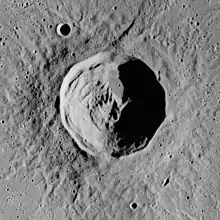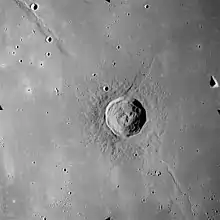Lambert (lunar crater)
Lambert is a lunar impact crater on the southern half of the Mare Imbrium basin. It was named after Swiss polymath Johann Heinrich Lambert.[1] It lies to the east and somewhat south of the slightly larger crater Timocharis. To the south is the smaller Pytheas, and some distance to the west-southwest is Euler.
 | |
| Coordinates | 25.8°N 21.0°W |
|---|---|
| Diameter | 30 km |
| Depth | 2.7 km |
| Colongitude | 21° at sunrise |
| Eponym | Johann Heinrich Lambert |

.png.webp)
The crater is relatively easy to locate due to its isolated position on the mare. It has an outer rampart, terraced inner walls, and a rough interior that has a comparable albedo to its surroundings. Instead of a central peak, a small craterler lies at the midpoint of the interior.
Just to the south of Lambert's ramparts is the lava-covered rim of Lambert R, a crater that is almost completely covered by the mare. The diameter of this ghost crater is larger than Lambert, but it is difficult to spot except when the Sun is at a very low angle, casting long shadows.
Lambert is a crater of Eratosthenian age.[2]
Satellite craters
By convention these features are identified on lunar maps by placing the letter on the side of the crater midpoint that is closest to Lambert.
| Lambert | Coordinates | Diameter, km |
|---|---|---|
| A | 26.46°N 21.49°W | 3,7 |
| B | 24.34°N 20.13°W | 3,9 |
| R | 23.88°N 20.66°W | 55,7 |
| T | 28.47°N 20.29°W | 3,7 |
| W | 24.49°N 22.66°W | 2,3 |
References
- "Lambert (lunar crater)". Gazetteer of Planetary Nomenclature. USGS Astrogeology Research Program.
- The geologic history of the Moon. USGS Professional Paper 1348. By Don E. Wilhelms, John F. McCauley, and Newell J. Trask. U.S. Government Printing Office, Washington: 1987. Table 12.2.
- Andersson, L. E.; Whitaker, E. A. (1982). NASA Catalogue of Lunar Nomenclature. NASA RP-1097.
- Bussey, B.; Spudis, P. (2004). The Clementine Atlas of the Moon. New York: Cambridge University Press. ISBN 978-0-521-81528-4.
- Cocks, Elijah E.; Cocks, Josiah C. (1995). Who's Who on the Moon: A Biographical Dictionary of Lunar Nomenclature. Tudor Publishers. ISBN 978-0-936389-27-1.
- McDowell, Jonathan (July 15, 2007). "Lunar Nomenclature". Jonathan's Space Report. Retrieved 2007-10-24.
- Menzel, D. H.; Minnaert, M.; Levin, B.; Dollfus, A.; Bell, B. (1971). "Report on Lunar Nomenclature by the Working Group of Commission 17 of the IAU". Space Science Reviews. 12 (2): 136–186. Bibcode:1971SSRv...12..136M. doi:10.1007/BF00171763. S2CID 122125855.
- Moore, Patrick (2001). On the Moon. Sterling Publishing Co. ISBN 978-0-304-35469-6.
- Price, Fred W. (1988). The Moon Observer's Handbook. Cambridge University Press. ISBN 978-0-521-33500-3.
- Rükl, Antonín (1990). Atlas of the Moon. Kalmbach Books. ISBN 978-0-913135-17-4.
- Webb, Rev. T. W. (1962). Celestial Objects for Common Telescopes (6th revised ed.). Dover. ISBN 978-0-486-20917-3.
- Whitaker, Ewen A. (1999). Mapping and Naming the Moon. Cambridge University Press. ISBN 978-0-521-62248-6.
- Wlasuk, Peter T. (2000). Observing the Moon. Springer. ISBN 978-1-85233-193-1.
External links
- LTO-40A3 Lambert — L&PI topographic map of crater and vicinity.